SoundersFC Soccer Shake Experiment
SoundersFC Soccer Shake
November 8, 2019
This “SoundersFC Soccer Shake” experiment is part of our routine training for rapid instrument installation and urban seismology and is being run with permission from the Seattle Sounders Football Club. Similar to monitoring the Seattle Seahawks football games a few years ago we will install seismographs at CenturyLink Field (this time only one in the stadium) and monitor the ground shaking due to fan enthusiasm both inside the stadium and at a site not far outside the stadium. Realtime seismograms will be available via our web pages during this experiment and this blog will be updated from time to time as this experiment progresses.
Everyone knows that enthusiastic sports fans can be very loud, particularly when cheering for their home team. However, as seismologists we are not so interested in sound levels as we are in ground vibrations. Fans simply yelling will be of no interest to us; however their jumping up and down should generate vibrations in the stadium and even be transmitted through the ground to sites at some distance. The SounderFC fans are particularly well known for their synchronized rhythmic jumping together, which should generate very strong seismic signals. Just how strong; that is the question we hope to answer.

Some Background
November 9, 2019
Before anyone gets too excited that this will be a unique experiment you should know that seismic recordings of sports fan activity is not a new thing. Both American football and real football (soccer) have had numerous cases of crowd generated vibrations being recorded by sensitive seismographs, usually near the stadium. One of the first I am aware of was the “Gol del terremoto” (earthquake goal) in Argentina in 1992. As recently as last year highly published soccer fan quakes were in the regular press and social media in Leicester, England, and Barcelona, Spain. One of the most unusual reports was from Cameroon in 2006 when widely distributed, very sensitive research seismographs showed slight wiggles all at the same time as important goals were scored by the national team. In this case it was attributed to people all over the country watching the match on TV who jumped up and down all at the same time. Thus, while widely recorded, it was from sources near each station.
We don't expect any major new revelations from our experiment this Sunday, but it provides a good opportunity for some of the recently hired PNSN staff to get experience with rapid seismograph mobilization and testing of our complete recording, displaying and analysis systems. In addition the Seattle Sounders in the MLS Cup at home should provide some really interesting seismic signals, and one never knows what might be learned when new and different sorts of data are obtained.
Our seismograph was installed this evening, but technical difficulties have prevented it from being recorded in the lab yet. We hope this problem will be fixed in the morning before the game.
At the Stadium
November 10, 2019
The monitoring crew, myself, Micky and Elizabeth arrived at the stadium at about 9:30am and after some delays got in to make final connection adjustments to our temporary seismograph, SFC. Once it got connected to the internet and data started flowing it has taken some time for it to catch up to real time (since it was storing data locally without the ability to send it until just a bit ago. SFC is located at the southwest corner of the stadium at ground level almost under the main SounderFC fan section. Here is a photo of the actual instrument installed with Doug, (field tech and outreach expert) being happy that it is working.
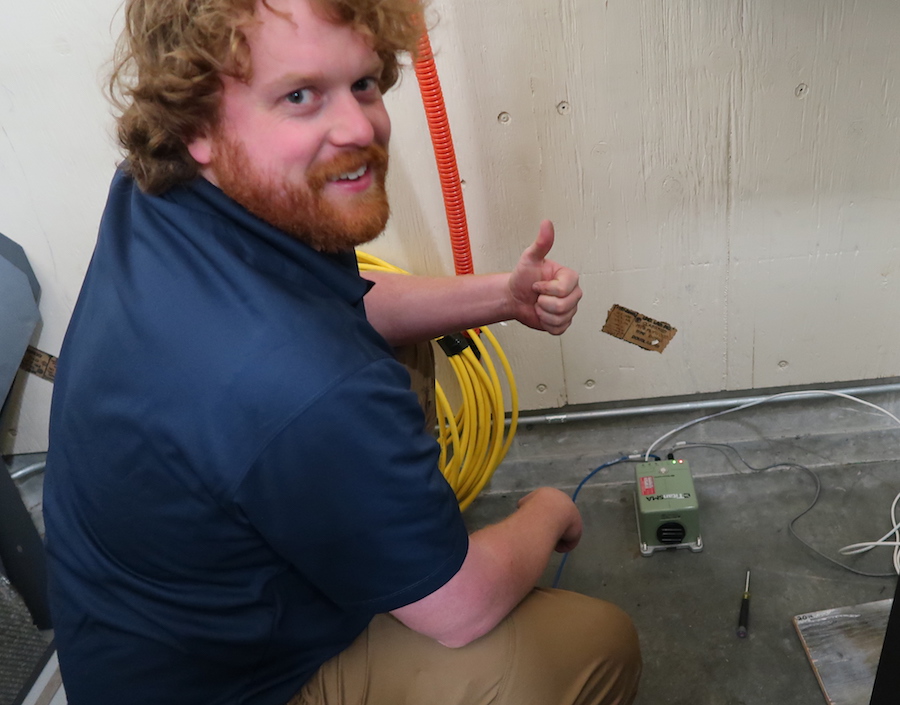
The three of us are in the press box with a good view of the fans in the south end and will be watching for when they get really wild and crazy... more wild and crazy than they are most of the time. Here we are waiting for the game to start.
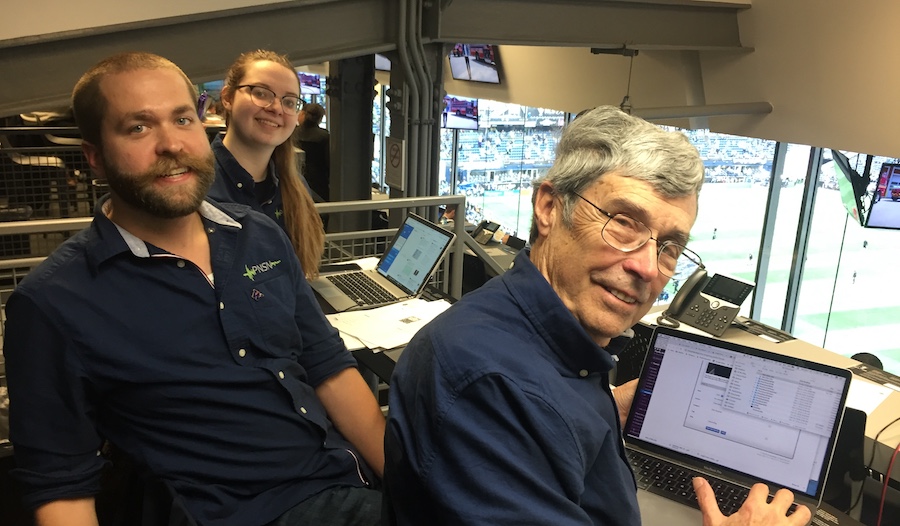
See the wiggles
Here are URLs to see the seismic data online:
Quickshake has very little delay and for the two nearby stations SFC (in the stadium( and KDK (just outside the stadium) can be found at:
The helicorder-like plots can be found at:
Note that there is a scaling problem because the SFC station was operating in a very noisy site for testing ealier in the day. Once the data catches up and during the game it should look OK.
Half Time
The first half is over and it was difficult to always associate seismic signals with what was going on in the stadium. At least one period seem to be very obvious with the south end fans jumping together. At first I thought it was a train going by but it was very much lined up with when the fans were jumping. Here is the spectrogram during that period:

Note timing in all of these plots is in UTC (8 hours ahead of local time). One may see lots of big signals on SFC during halftime (after 20:57) which is due to the fact that our instrument is in a closet just outside the press interview room and near the area where lots of people go by before, after the game and during halftime. Of course even during the game some local noise may result that we will not know the source of.
Second half
We caught the spectrograms of the Sounder's goal on both stations. The differences in frequency between the two stations is interesting but we don't yet understand it.

At first glance the second goal seem to have been stronger than the first but the third maybe not quite as strong. It has been challenging to try and keep up with what the fans were doing in the excitement of the game. It will take some additional analysis to understand all the different types of signals that we recorded and how strong due to what actions. Check back in a few days.... or I may go on vacation and it will take longer.
Congratulation Sounders and the great Sounder FANS!!
One final plot today provided by Paul Bodin in the quiet of the lab filtered and scaled the SFC trace so that it covered the whole game. There are parts that we don't yet know about but the goals are very obvious.

A bit of additional analysis
Nov. 12, 2019
Back in the lab using display and analysis techniques and having more time and using my notes of what fans seemed to be doing I have a few interesting observations. Before going into detail, here is a review of where the stations are located, their instrument type and analysis technique. The two stations of interest are SFC, which was located in a communications utility closet under the southwest corner of the stands not far from the player and press entrance to the stadium, and KDK located in a nearby building just west of the stadium about 150 meters away. Both instruments are Titan strong-motion accelerographs (flat response to acceleration) with a gain of about 220,000 counts/m/s**2. This means that a signal with a peak value of 400 counts comes out to 0.0018 m/s**2 or about 0.02 %g where g is the acceleration of gravity. Typically it takes shaking of around 0.01 %g to be felt by people who are not moving around.
One thing we realized at the time of the game was that the instrument at SFC was not in a good place because of local machinery. Just about the time the game started very strong constant shaking at high frequency started up and continued for most of the game. We think this was some sort of fan or ventilation system. There were also other local vibrations due to people walking within a few feet or other machinery. Fortunately this “noise” signal can mostly be filtered out by applying a low-pass or band-pass filter to the data leaving signals that were due to more distant sources visible, like the crowd jumping in the stands above. Station KDK does not have this high-frequency machinery noise but does have some periodic signals due to motor vehicles on the nearby streets.
Analysis displays I use below include time-series plots of the vertical channel of each instrument and spectrograms of different times during the game illustrating what causes different sorts of signals. Spectrograms are colorful plots in which time is on the horizontal axes and frequency is on the vertical axes, and color is proportional to the signal amplitude at that time and frequency; warm colors are for stronger signals and cool colors for the weaker ones.
First I show a minute-long seismogram around each of the Sounders' goals as recorded on station KDK. These have been filtered from 1 to 26 Hz to best display the signal generated by the crowd motions. Peak accelerations are about 0.020 %g, 0.046 %g and 0.28 %g respectively. Note that for the first goal the relatively strong shaking goes on for most of a minute, and in all three cases there are slightly stronger and weaker periods of shaking as more or fewer people get involved in jumping.
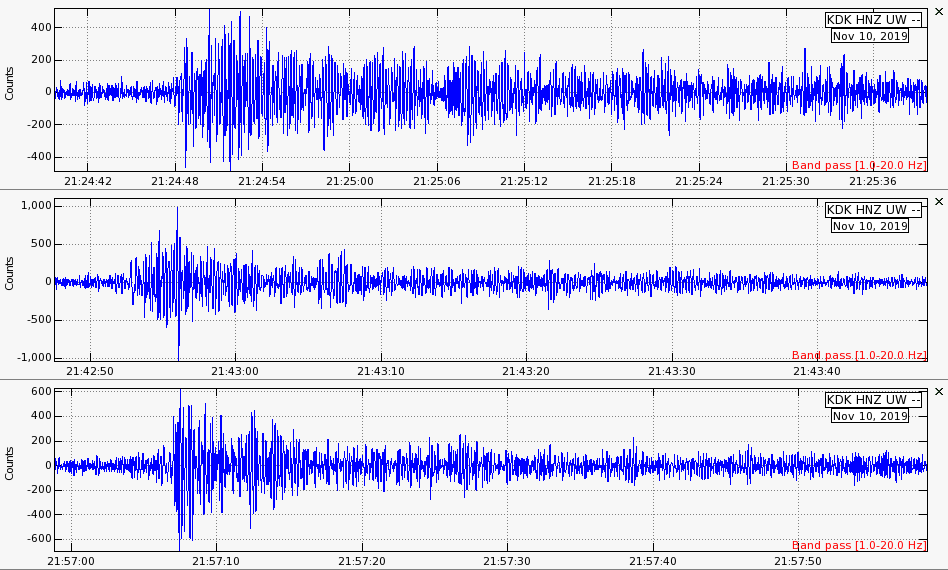
We will now look at the first goal again but in different ways and at the closer station, SFC. Here a raw seismogram is shown at the top, a spectrogram next and then two different filtered versions of the seismogram. In the first trace the evidence for the crowd shaking is almost impossible to see, because it is drowned out by almost constant strong, high-frequency vibrations. The shaking is at 0.08 %g, one would think strong enough to be easily felt by someone sitting next to the instrument. However, due to its high-frequency, it might be felt only as a slight buzz. From the spectrogram one can see a very strong (dark red) line at about 45 Hz and several other weaker lines down to 30 Hz. Thus, the effect of the local machinery noise can be removed if the traces are filtered to remove the high-frequency as was done in the third trace. The strong goal reaction signal is now easily seen. Filtering to even lower frequencies (fourth trace) one can see a second strong signal starting about 21:26 Z and lasting for just over 20 seconds. This can even be seen in the spectrogram as a couple of lines down in the range of 2-5 Hz. What could this be due to?
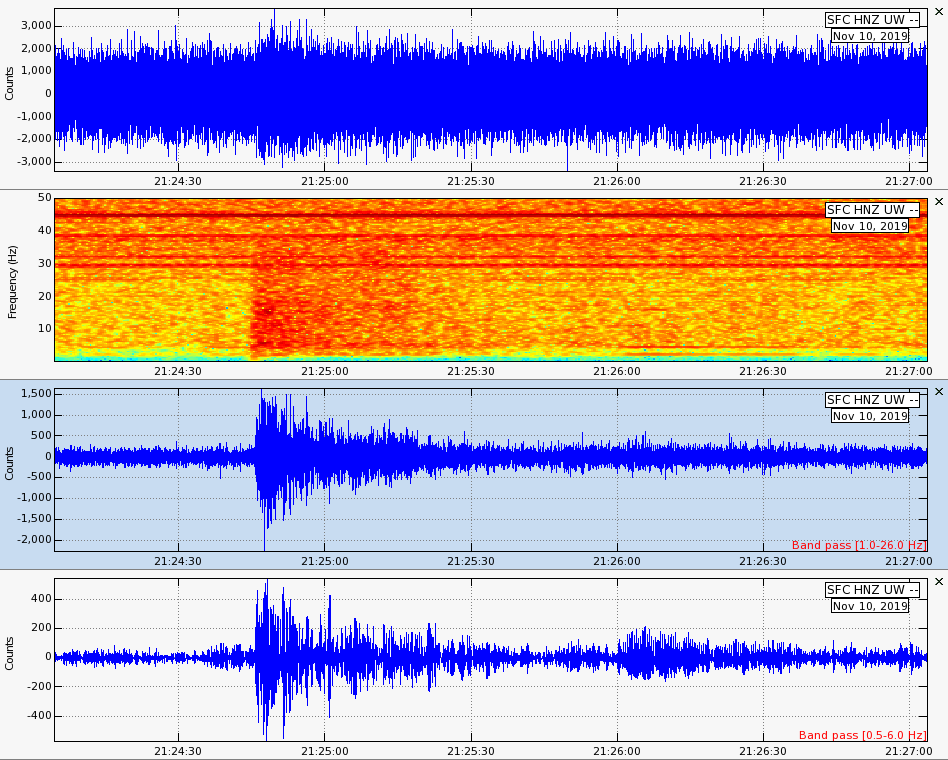
Looking through more of the game I found similar signals fairly often. There was one case in which it was particularly strong and long lasting and is shown in the following figure. My notes for this period of time say: “20:48:00: up to two minutes possible train but strong rhythmic jumping of south-end fans going on exactly the same time”. From previous experience we know that trains going by the east side of the stadium generate seismic signals. However, they are always more broad-band (showing all frequencies about the same) and start more gradually and last longer (see the last figure for an example long before the game). In this case the spectrogram shows very strong lines at about 2 and 4 Hz with weaker lines above. Low-pass filtering the seismograms for station SFC (3rd trace) and KDK (4th trace) one can even see the individual peaks. There are about 20 of them in 10 seconds, so 2 per second or 2 Hz. Indeed the synchronized fan jumping (“jump-quakes”) in time to the fan leaders and a drum is very effectively being recorded strongly even outside the stadium. It has an amplitude comparable to the more random signals generated by goal enthusiasm, which probably is due to people all over the stadium jumping but not in a synchronized way. (And there are many other cases over the whole game).
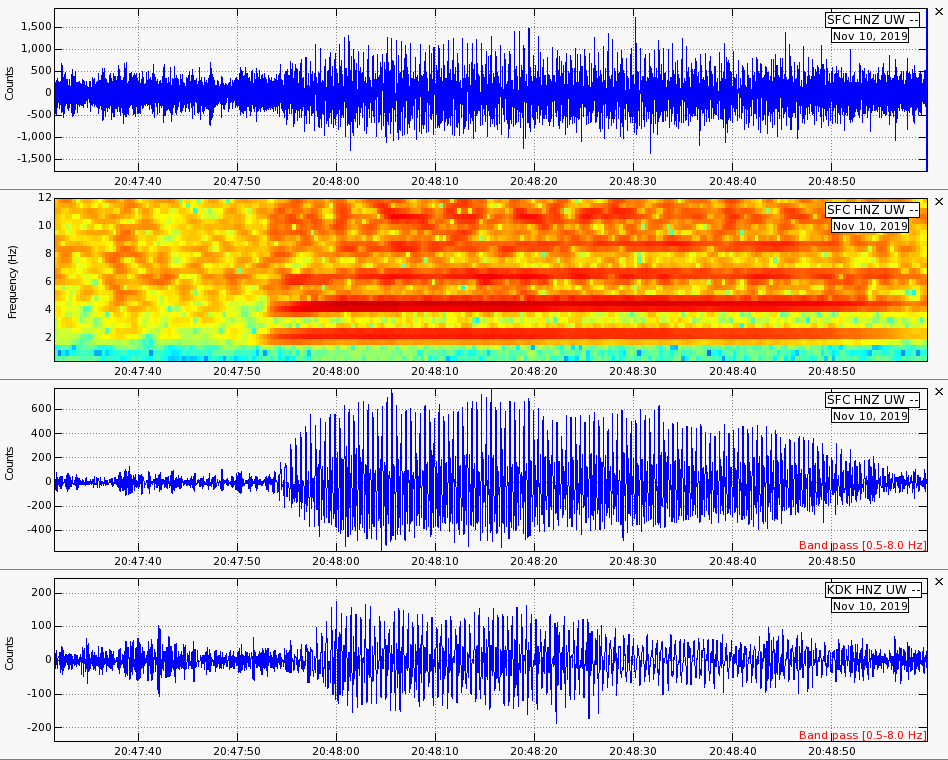
There are many other seismic signals that we can now interpret by having detailed notes of fan reaction to field events such the player introduction march, near goals, great saves and the end of the game and even the post game celebration. Some are subtle but clearly have characteristic signals. Of some interest is what these signals looked like long before the game or even before there were many people in the stadium. The following shows a 20 minute period including the signal from a train which can even weakly be seen on KDK on the opposite side of the stadium.
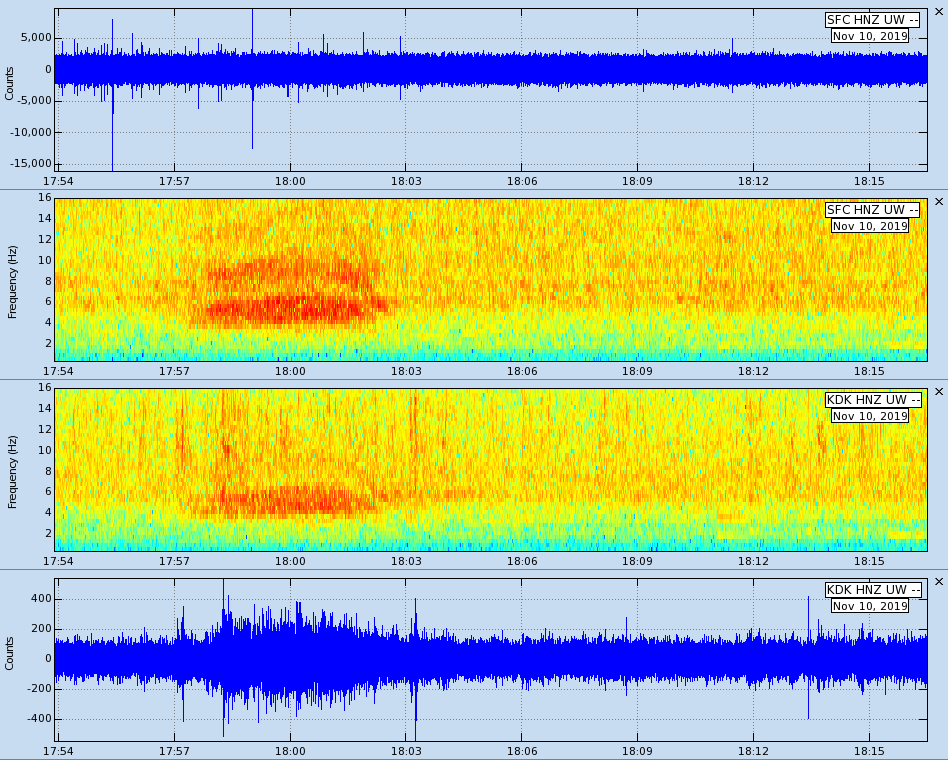
Some Comparisons
Those who remember our previous monitoring of sports events at Century Link Field will remember the "beast-quake" and other Seahawk playoff games we reported on. While American Football and Soccer are very different sports the fan enthusiasm for each turns out to be quite comparable from a seismic point of view. Seahawk touchdowns and Sounder goals generated shaking of roughly the same levels, though touchdowns had a longer buildup since a long touchdown run ("beast-quake") could last for several tens of seconds, and a soccer goal can occur suddenly without much build up. Similarly the Seahawk “dance-quakes” and the Sounder “jump-quakes” are comparable in size, though the jump-quakes have a sharper spectral peak, since the participants are well synchronized, and the dance-quakes are more free form. However, the strongest signal by a bit was the “chant-quake” of 2017 when much of the stadium somehow got coordinated chanting (and jumping together), “dee-fence-now” all together.
More analysis may reveal other interesting aspects of this experiment. However, for this blog we will leave it here.